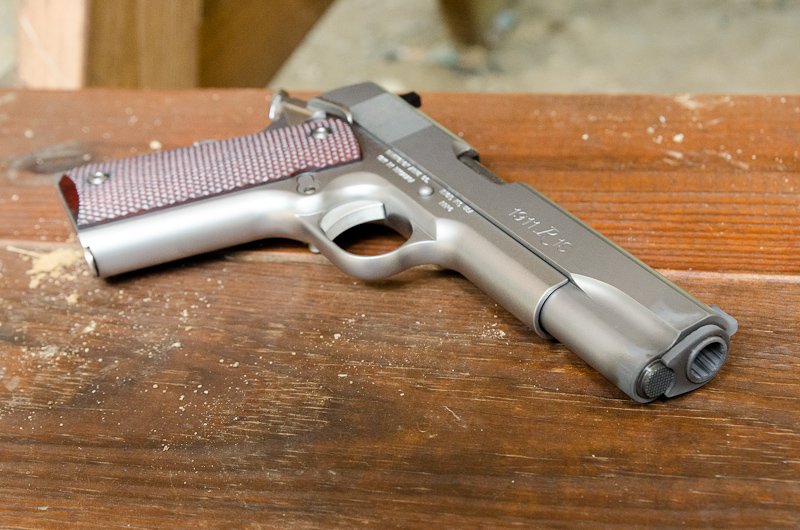Deep Creek Rock
.._. .._ _._. _._ .._
Just so you know they make godamn crankshafts, and connecting rods on cars using MIM. Yes MIM is cheaper & faster to make - but there are some advantages as well. It is NOT Pot metal. And even those hand made beloved custom guns - break (not brake!) Les Baer had a run of cracked hammers - but thats not possible on machined parts right? There isnt a single non custom -production gun on the market that is using some form of MIM. So unless your buying really old guns or 100 % custom - your buying some form of MIM.
Heres a little tibit to maybe help pull your head out of your ass about MIM
Process
An early developer of the process during the 1970s was Dr. Raymond E. Wiech Jr., who refined MIM technology as co-founder of a California company named Parmatech; the name being condensed from the phrase 'particle materials technology'.[2][3] Dr. Wiech later patented [4] his process, and it was widely adopted for manufacturing use in the 1980s. Competing processes included pressed powder sintering, investment casting, and machining. MIM gained recognition throughout the 1990s as improvements to subsequent conditioning processes resulted in an end product that performs similar or better than those made through competing processes. MIM technology improved cost efficiency through high volume production to 'near-net-shape', negated costly, additional operations left unrealized in competing processes, and met rigid dimensional and metallurgical specifications.
The process steps involve combining metal powders with wax and plastic binders to produce the 'feedstock' mix that is injected as a liquid into a hollow mold using plastic injection molding machines. The 'green part' is cooled and de-molded in the plastic molding machine. Next, a portion of the binder material is removed using solvent, thermal furnaces, catalytic process, or a combination of methods. The resulting, fragile and porous (2-4% "air") part, in a condition called "brown" stage, requires the metal to be condensed in a furnace process called Sintering. MIM parts are sintered at temperatures nearly high enough to melt the entire metal part outright (up to 1450 degrees Celsius), at which the metal particle surfaces bind together to result in a final, 96-99% solid density. The end-product MIM metal has comparable mechanical and physical properties with parts made using classic metalworking methods, and MIM materials are compatible with the same subsequent metal conditioning treatments such as plating, passivating, annealing, carburizing, nitriding, and precipitation hardening.
[edit] ApplicationsThe window of economic advantage in metal injection molded parts lies in complexity and volume for small-size parts. MIM materials are comparable to metal formed by competing methods, and final products are used in a broad range of industrial, commercial, medical, dental, firearms, aerospace, and automotive applications. Dimensional tolerances of +/-.003" per linear inch can be commonly held, and far closer restrictions on tolerance are possible with expert knowledge of molding and sintering. MIM can produce parts where it is difficult, or even impossible, to efficiently manufacture an item through other means of fabrication. Increased costs for traditional manufacturing methods inherent to part complexity, such as internal/external threads, miniaturization, or brand identity marking, typically do not increase the cost in a MIM operation due to the flexibility of injection molding.
There is a broad range of materials available when utilizing the MIM process. Traditional metalworking processes often involve a significant amount of material waste, which makes MIM a highly efficient option for the fabrication of complex components consisting of expensive/special alloys (Cobalt-chrome, 17-4 PH Stainless Steel). MIM is a viable option when extremely thin walls specifications (i.e. 0.008” thick) are required. Additionally, EMI shielding (Electromagnetic Interference) requirements has presented unique challenges, which are being successfully attained through the utilization of specialty alloys (ASTM A753 Type 4).
Heres a little tibit to maybe help pull your head out of your ass about MIM
Process
An early developer of the process during the 1970s was Dr. Raymond E. Wiech Jr., who refined MIM technology as co-founder of a California company named Parmatech; the name being condensed from the phrase 'particle materials technology'.[2][3] Dr. Wiech later patented [4] his process, and it was widely adopted for manufacturing use in the 1980s. Competing processes included pressed powder sintering, investment casting, and machining. MIM gained recognition throughout the 1990s as improvements to subsequent conditioning processes resulted in an end product that performs similar or better than those made through competing processes. MIM technology improved cost efficiency through high volume production to 'near-net-shape', negated costly, additional operations left unrealized in competing processes, and met rigid dimensional and metallurgical specifications.
The process steps involve combining metal powders with wax and plastic binders to produce the 'feedstock' mix that is injected as a liquid into a hollow mold using plastic injection molding machines. The 'green part' is cooled and de-molded in the plastic molding machine. Next, a portion of the binder material is removed using solvent, thermal furnaces, catalytic process, or a combination of methods. The resulting, fragile and porous (2-4% "air") part, in a condition called "brown" stage, requires the metal to be condensed in a furnace process called Sintering. MIM parts are sintered at temperatures nearly high enough to melt the entire metal part outright (up to 1450 degrees Celsius), at which the metal particle surfaces bind together to result in a final, 96-99% solid density. The end-product MIM metal has comparable mechanical and physical properties with parts made using classic metalworking methods, and MIM materials are compatible with the same subsequent metal conditioning treatments such as plating, passivating, annealing, carburizing, nitriding, and precipitation hardening.
[edit] ApplicationsThe window of economic advantage in metal injection molded parts lies in complexity and volume for small-size parts. MIM materials are comparable to metal formed by competing methods, and final products are used in a broad range of industrial, commercial, medical, dental, firearms, aerospace, and automotive applications. Dimensional tolerances of +/-.003" per linear inch can be commonly held, and far closer restrictions on tolerance are possible with expert knowledge of molding and sintering. MIM can produce parts where it is difficult, or even impossible, to efficiently manufacture an item through other means of fabrication. Increased costs for traditional manufacturing methods inherent to part complexity, such as internal/external threads, miniaturization, or brand identity marking, typically do not increase the cost in a MIM operation due to the flexibility of injection molding.
There is a broad range of materials available when utilizing the MIM process. Traditional metalworking processes often involve a significant amount of material waste, which makes MIM a highly efficient option for the fabrication of complex components consisting of expensive/special alloys (Cobalt-chrome, 17-4 PH Stainless Steel). MIM is a viable option when extremely thin walls specifications (i.e. 0.008” thick) are required. Additionally, EMI shielding (Electromagnetic Interference) requirements has presented unique challenges, which are being successfully attained through the utilization of specialty alloys (ASTM A753 Type 4).

![penknife-spyderco-c109slp[1].jpg penknife-spyderco-c109slp[1].jpg](https://www.mdshooters.com/data/attachments/50/50549-ede6d7175f071750e2a05b9dd7e781db.jpg)








